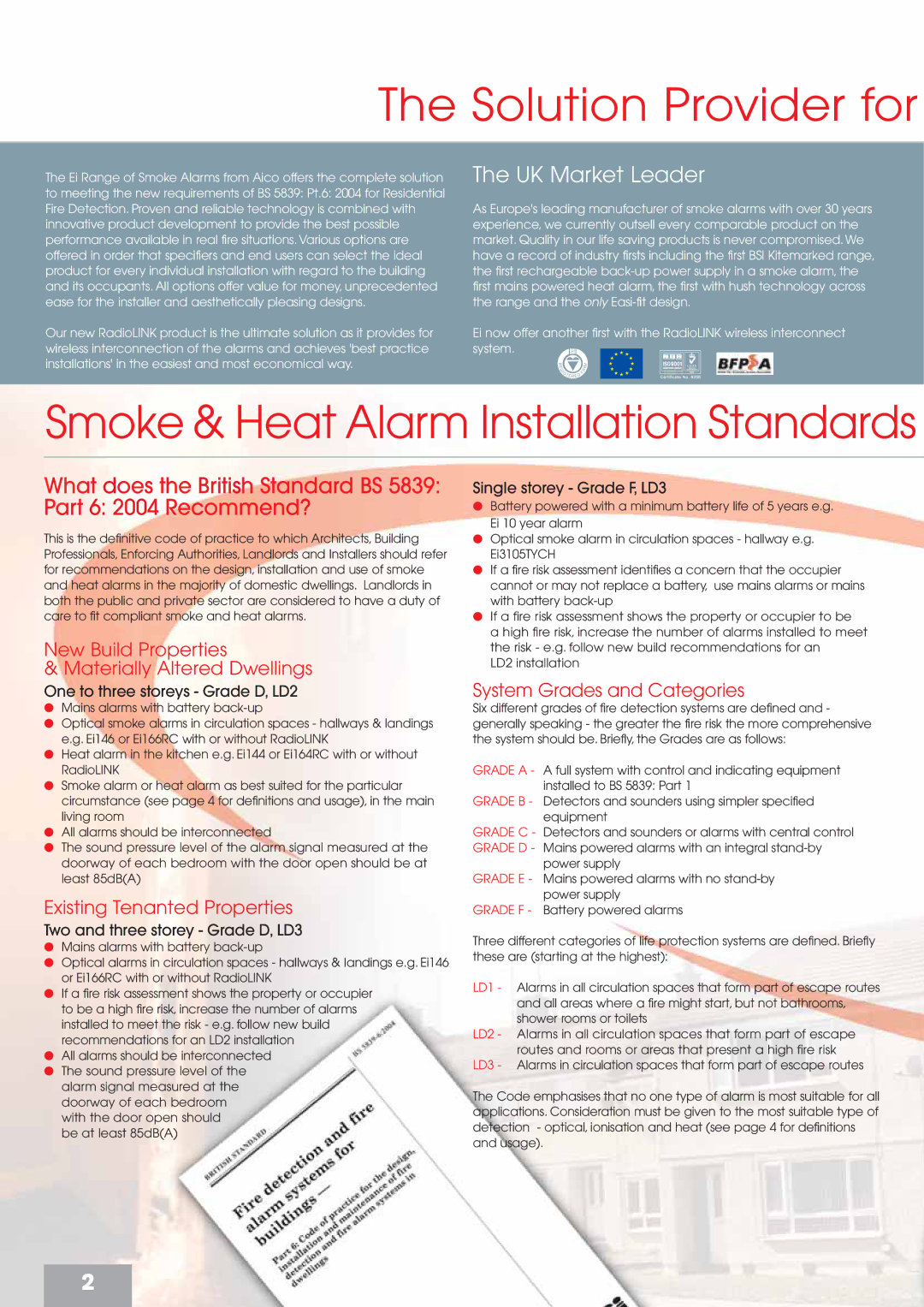
The Solution Provider for
The Ei Range of Smoke Alarms from Aico offers the complete solution to meeting the new requirements of BS 5839: Pt.6: 2004 for Residential Fire Detection. Proven and reliable technology is combined with innovative product development to provide the best possible performance available in real fire situations. Various options are offered in order that specifiers and end users can select the ideal product for every individual installation with regard to the building and its occupants. All options offer value for money, unprecedented ease for the installer and aesthetically pleasing designs.
Our new RadioLINK product is the ultimate solution as it provides for wireless interconnection of the alarms and achieves 'best practice installations' in the easiest and most economical way.
The UK Market Leader
As Europe's leading manufacturer of smoke alarms with over 30 years experience, we currently outsell every comparable product on the market. Quality in our life saving products is never compromised. We have a record of industry firsts including the first BSI Kitemarked range, the first rechargeable
Ei now offer another first with the RadioLINK wireless interconnect system. ![]()
![]()
![]()
Smoke & Heat Alarm Installation Standards
What does the British Standard BS 5839: Part 6: 2004 Recommend?
This is the definitive code of practice to which Architects, Building Professionals, Enforcing Authorities, Landlords and Installers should refer for recommendations on the design, installation and use of smoke and heat alarms in the majority of domestic dwellings. Landlords in both the public and private sector are considered to have a duty of care to fit compliant smoke and heat alarms.
New Build Properties
& Materially Altered Dwellings
One to three storeys - Grade D, LD2
●Mains alarms with battery
●Optical smoke alarms in circulation spaces - hallways & landings e.g. Ei146 or Ei166RC with or without RadioLINK
●Heat alarm in the kitchen e.g. Ei144 or Ei164RC with or without RadioLINK
●Smoke alarm or heat alarm as best suited for the particular circumstance (see page 4 for definitions and usage), in the main living room
●All alarms should be interconnected
●The sound pressure level of the alarm signal measured at the doorway of each bedroom with the door open should be at least 85dB(A)
Existing Tenanted Properties
Two and three storey - Grade D, LD3
●Mains alarms with battery
●Optical alarms in circulation spaces - hallways & landings e.g. Ei146 or Ei166RC with or without RadioLINK
●If a fire risk assessment shows the property or occupier to be a high fire risk, increase the number of alarms installed to meet the risk - e.g. follow new build recommendations for an LD2 installation
●All alarms should be interconnected
●The sound pressure level of the alarm signal measured at the doorway of each bedroom with the door open should be at least 85dB(A)
Single storey - Grade F, LD3
●Battery powered with a minimum battery life of 5 years e.g. Ei 10 year alarm
●Optical smoke alarm in circulation spaces - hallway e.g. Ei3105TYCH
●If a fire risk assessment identifies a concern that the occupier cannot or may not replace a battery, use mains alarms or mains with battery
●If a fire risk assessment shows the property or occupier to be
a high fire risk, increase the number of alarms installed to meet the risk - e.g. follow new build recommendations for an
LD2 installation
System Grades and Categories
Six different grades of fire detection systems are defined and - generally speaking - the greater the fire risk the more comprehensive the system should be. Briefly, the Grades are as follows:
GRADE A - A full system with control and indicating equipment installed to BS 5839: Part 1
GRADE B - Detectors and sounders using simpler specified equipment
GRADE C - Detectors and sounders or alarms with central control GRADE D - Mains powered alarms with an integral
power supply
GRADE E - Mains powered alarms with no
GRADE F - Battery powered alarms
Three different categories of life protection systems are defined. Briefly these are (starting at the highest):
LD1 - Alarms in all circulation spaces that form part of escape routes and all areas where a fire might start, but not bathrooms, shower rooms or toilets
LD2 - Alarms in all circulation spaces that form part of escape routes and rooms or areas that present a high fire risk
LD3 - Alarms in circulation spaces that form part of escape routes
The Code emphasises that no one type of alarm is most suitable for all applications. Consideration must be given to the most suitable type of detection - optical, ionisation and heat (see page 4 for definitions and usage).
2
